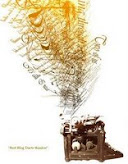The term “art brut” means “raw art.” It is used to describe art created by talented artists living outside of society. Art brut is the art of the insane. The name didn’t come about until the mid-1940s and it was soon used to refer to other forms of outsider art. But that’s a topic for another day.
Until the mid-1800s no one paid attention to the artwork created by mental patients. Psychiatrists such as Dr. Paul Gaston Meunier, Dr. Auguste Marie, and Dr. Charles Ladame changed this. They began to collect the artwork because they thought it could help grant new information about the minds of their patients.
 In the 1920s, as you know, abstract art movements were forming and gaining popularity. Artists like Wassily Kandinsky were creating art without recognizable subjects. Their art was based on feeling. They tried to paint emotions onto canvas and people accepted the art that was created.
In the 1920s, as you know, abstract art movements were forming and gaining popularity. Artists like Wassily Kandinsky were creating art without recognizable subjects. Their art was based on feeling. They tried to paint emotions onto canvas and people accepted the art that was created.
The idea of putting pencil or pen or brush to paper and letting it wander with the mind made people look differently at the art of the insane. Those doodles and scribbles no longer seemed so silly.
 As it turned out, the insane created more than just doodles and scribbles. Some created very realistic sketches of life. Others carved abstract sculptures. Some created ordered, patterned drawings, filled with every imaginable color. Just like the work of mentally healthy artists, the artwork of the insane varied in style and could be seen as strange or disturbing or even beautiful.
As it turned out, the insane created more than just doodles and scribbles. Some created very realistic sketches of life. Others carved abstract sculptures. Some created ordered, patterned drawings, filled with every imaginable color. Just like the work of mentally healthy artists, the artwork of the insane varied in style and could be seen as strange or disturbing or even beautiful.
In 1922, Dr. Hans Prinzhorn published a book on the art of the insane. He also set up a gallery of artwork he had collected. The book and the gallery made people aware of the art made by the mentally ill. And the most interesting thing—the artwork influenced “normal” artists! The Surrealists were especially inspired.
 Look at the pictures I’ve included. (The first was painted by Adolf Wolfli, the second by Franz Karl Buhler, and the third by August Natterer.) Tomorrow I’ll tell you about Adolf Wolfli, a mentally ill artist who is remembered today by many as a creative genius.
Look at the pictures I’ve included. (The first was painted by Adolf Wolfli, the second by Franz Karl Buhler, and the third by August Natterer.) Tomorrow I’ll tell you about Adolf Wolfli, a mentally ill artist who is remembered today by many as a creative genius.
Thanks to BeverlyKayeGallery for suggesting this topic. I’m having a great time researching it and look forward to the next week or so of posts! Click over to the BeverlyKayeGallery blog to learn more about art brut and outsider art.
Return to main page.
Until the mid-1800s no one paid attention to the artwork created by mental patients. Psychiatrists such as Dr. Paul Gaston Meunier, Dr. Auguste Marie, and Dr. Charles Ladame changed this. They began to collect the artwork because they thought it could help grant new information about the minds of their patients.
 In the 1920s, as you know, abstract art movements were forming and gaining popularity. Artists like Wassily Kandinsky were creating art without recognizable subjects. Their art was based on feeling. They tried to paint emotions onto canvas and people accepted the art that was created.
In the 1920s, as you know, abstract art movements were forming and gaining popularity. Artists like Wassily Kandinsky were creating art without recognizable subjects. Their art was based on feeling. They tried to paint emotions onto canvas and people accepted the art that was created.The idea of putting pencil or pen or brush to paper and letting it wander with the mind made people look differently at the art of the insane. Those doodles and scribbles no longer seemed so silly.
 As it turned out, the insane created more than just doodles and scribbles. Some created very realistic sketches of life. Others carved abstract sculptures. Some created ordered, patterned drawings, filled with every imaginable color. Just like the work of mentally healthy artists, the artwork of the insane varied in style and could be seen as strange or disturbing or even beautiful.
As it turned out, the insane created more than just doodles and scribbles. Some created very realistic sketches of life. Others carved abstract sculptures. Some created ordered, patterned drawings, filled with every imaginable color. Just like the work of mentally healthy artists, the artwork of the insane varied in style and could be seen as strange or disturbing or even beautiful.In 1922, Dr. Hans Prinzhorn published a book on the art of the insane. He also set up a gallery of artwork he had collected. The book and the gallery made people aware of the art made by the mentally ill. And the most interesting thing—the artwork influenced “normal” artists! The Surrealists were especially inspired.
 Look at the pictures I’ve included. (The first was painted by Adolf Wolfli, the second by Franz Karl Buhler, and the third by August Natterer.) Tomorrow I’ll tell you about Adolf Wolfli, a mentally ill artist who is remembered today by many as a creative genius.
Look at the pictures I’ve included. (The first was painted by Adolf Wolfli, the second by Franz Karl Buhler, and the third by August Natterer.) Tomorrow I’ll tell you about Adolf Wolfli, a mentally ill artist who is remembered today by many as a creative genius.Thanks to BeverlyKayeGallery for suggesting this topic. I’m having a great time researching it and look forward to the next week or so of posts! Click over to the BeverlyKayeGallery blog to learn more about art brut and outsider art.
Return to main page.








No comments:
Post a Comment